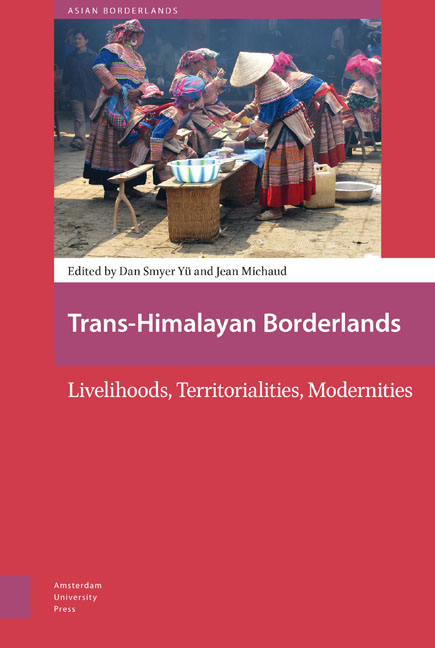Book contents
- Frontmatter
- Contents
- Acknowledgements
- Introduction: Trans-Himalayas as Multistate Margins
- I Territory, Worldviews, and Power Through Time
- 1 Adjusting Livelihood Structure in the Southeast Asian Massif
- 2 The Properties of Territory in Nepal’s State of Transformation
- 3 Trans-Himalayan Buddhist Secularities: Sino-Indian Geopolitics of Territoriality in Indo-Tibetan Interface
- 4 Buddhist Books on Trans-Himalayan Pathways: Materials and Technologies Connecting People and Ecological Environments in a Transnational Landscape
- 5 Seeking China's Back Door: On English Handkerchiefs and Global Local Markets in the Early Nineteenth Century
- II Livelihood Reconstructions, Flows, and Trans-Himalayan Modernities
- 6 Contested Modernities: Place, Subjectivity, and Himalayan Dam Infrastructures
- 7 Plurality and Plasticity of Everyday Humanitarianism in the Karen Conflict
- 8 Being Modern: Livelihood Reconstruction among Land-lost Peasants in Chenggong (Kunming)
- 9 Tibetan Wine Production, Taste of Place, and Regional Niche Identities in Shangri-La, China
- 10 Tea and Merit: Landscape Making in the Ritual Lives of the De’ang People in Western Yunnan
- 11 In-between Poppy and Rubber Fields: Experimenting a Transborder Livelihood among the Akha in the Northwestern Frontier of Laos
- 12 A Fortuitous Frontier Opportunity: Cardamom Livelihoods in the Sino-Vietnamese Borderlands
- Conclusion: Frictions in Trans-Himalayan Studies
- Index
5 - Seeking China's Back Door: On English Handkerchiefs and Global Local Markets in the Early Nineteenth Century
Published online by Cambridge University Press: 12 December 2020
- Frontmatter
- Contents
- Acknowledgements
- Introduction: Trans-Himalayas as Multistate Margins
- I Territory, Worldviews, and Power Through Time
- 1 Adjusting Livelihood Structure in the Southeast Asian Massif
- 2 The Properties of Territory in Nepal’s State of Transformation
- 3 Trans-Himalayan Buddhist Secularities: Sino-Indian Geopolitics of Territoriality in Indo-Tibetan Interface
- 4 Buddhist Books on Trans-Himalayan Pathways: Materials and Technologies Connecting People and Ecological Environments in a Transnational Landscape
- 5 Seeking China's Back Door: On English Handkerchiefs and Global Local Markets in the Early Nineteenth Century
- II Livelihood Reconstructions, Flows, and Trans-Himalayan Modernities
- 6 Contested Modernities: Place, Subjectivity, and Himalayan Dam Infrastructures
- 7 Plurality and Plasticity of Everyday Humanitarianism in the Karen Conflict
- 8 Being Modern: Livelihood Reconstruction among Land-lost Peasants in Chenggong (Kunming)
- 9 Tibetan Wine Production, Taste of Place, and Regional Niche Identities in Shangri-La, China
- 10 Tea and Merit: Landscape Making in the Ritual Lives of the De’ang People in Western Yunnan
- 11 In-between Poppy and Rubber Fields: Experimenting a Transborder Livelihood among the Akha in the Northwestern Frontier of Laos
- 12 A Fortuitous Frontier Opportunity: Cardamom Livelihoods in the Sino-Vietnamese Borderlands
- Conclusion: Frictions in Trans-Himalayan Studies
- Index
Summary
Abstract
This chapter focuses on the early nineteenth century, when European mercantile commerce and British colonial military forces simultaneously began to make inroads east of the Brahmaputra River, into Assam and the Surma-Barak lowlands toward Burma and Yunnan. From early on, the purpose was to secure the overland routes to the markets of the Chinese Middle Empire. The study is explorative in its endeavor to establish the movement of mercantile commercial interests and capital into the territories that were part of the old southwest Silk Road network. It focuses on how British officers, as they explored the natural resources and markets of these territories, observed and handled the day-to-day transactions that made up the region's social, political, and economic relations. It also discusses how the British East India Company introduced new boundaries into complex sociopolitical and ecological environments for the purpose of securing and mapping imperial visions.
Keywords: British Empire, Indian colonial history, transregional South Asia, colonial trade, Burma, Northeast India
In 1836, an English officer on a mission to explore the markets along the Irrawaddy River in Burma made notes on valuable goods. One item in particular drew his attention: an English cotton handkerchief. As he traveled north on the river, he found the economy in poor shape. Most of the towns that he passed were hit by the postwar economy and by a conflict within the royal court, which was just about to erupt into civil war. The large war indemnity imposed after the war against the British East India Company (EIC) ten years earlier now threatened to empty the country's coffers. Nevertheless, the larger markets and key points on the arteries of commerce still served visitors with just about any commodity they could wish for. But the officer does not seem to have expected to find handkerchiefs from home.
J.G. Bayfield of the medical establishment of Madras headed one of the first of the EIC's expeditions in Burma. The final destination of his journey was the Patkai Pass in the far northwest, where the Hukawng Valley met upper Assam. Before returning to Rangoon, he had been ordered to determine the exact place of a boundary between Burma and the British territories.
- Type
- Chapter
- Information
- Trans-Himalayan BorderlandsLivelihoods, Territorialities, Modernities, pp. 125 - 144Publisher: Amsterdam University PressPrint publication year: 2017
- 1
- Cited by



